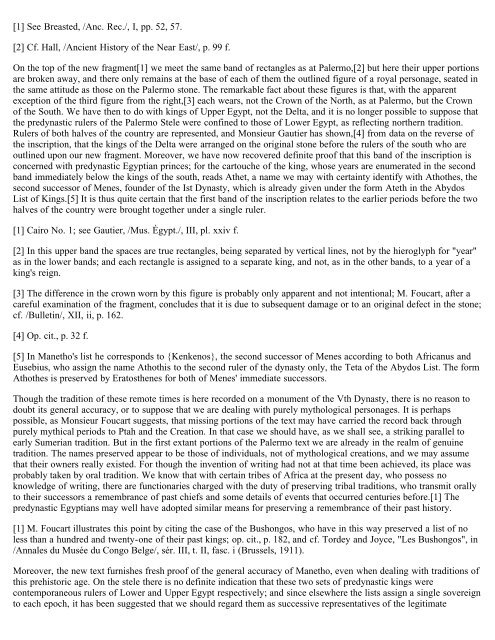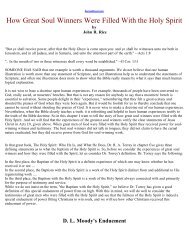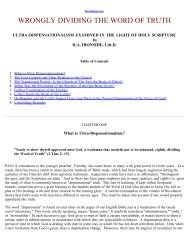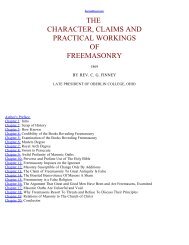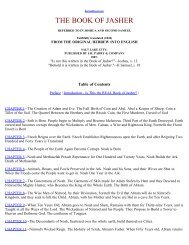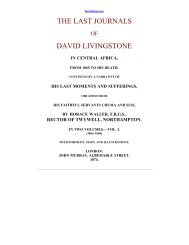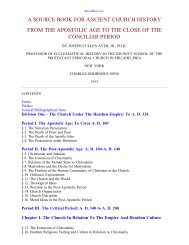Legends of Babylon and Egypt in Relation to Hebrew Tradition.pdf
Legends of Babylon and Egypt in Relation to Hebrew Tradition.pdf
Legends of Babylon and Egypt in Relation to Hebrew Tradition.pdf
You also want an ePaper? Increase the reach of your titles
YUMPU automatically turns print PDFs into web optimized ePapers that Google loves.
[1] See Breasted, /Anc. Rec./, I, pp. 52, 57.<br />
[2] Cf. Hall, /Ancient His<strong>to</strong>ry <strong>of</strong> the Near East/, p. 99 f.<br />
On the <strong>to</strong>p <strong>of</strong> the new fragment[1] we meet the same b<strong>and</strong> <strong>of</strong> rectangles as at Palermo,[2] but here their upper portions<br />
are broken away, <strong>and</strong> there only rema<strong>in</strong>s at the base <strong>of</strong> each <strong>of</strong> them the outl<strong>in</strong>ed figure <strong>of</strong> a royal personage, seated <strong>in</strong><br />
the same attitude as those on the Palermo s<strong>to</strong>ne. The remarkable fact about these figures is that, with the apparent<br />
exception <strong>of</strong> the third figure from the right,[3] each wears, not the Crown <strong>of</strong> the North, as at Palermo, but the Crown<br />
<strong>of</strong> the South. We have then <strong>to</strong> do with k<strong>in</strong>gs <strong>of</strong> Upper <strong>Egypt</strong>, not the Delta, <strong>and</strong> it is no longer possible <strong>to</strong> suppose that<br />
the predynastic rulers <strong>of</strong> the Palermo Stele were conf<strong>in</strong>ed <strong>to</strong> those <strong>of</strong> Lower <strong>Egypt</strong>, as reflect<strong>in</strong>g northern tradition.<br />
Rulers <strong>of</strong> both halves <strong>of</strong> the country are represented, <strong>and</strong> Monsieur Gautier has shown,[4] from data on the reverse <strong>of</strong><br />
the <strong>in</strong>scription, that the k<strong>in</strong>gs <strong>of</strong> the Delta were arranged on the orig<strong>in</strong>al s<strong>to</strong>ne before the rulers <strong>of</strong> the south who are<br />
outl<strong>in</strong>ed upon our new fragment. Moreover, we have now recovered def<strong>in</strong>ite pro<strong>of</strong> that this b<strong>and</strong> <strong>of</strong> the <strong>in</strong>scription is<br />
concerned with predynastic <strong>Egypt</strong>ian pr<strong>in</strong>ces; for the car<strong>to</strong>uche <strong>of</strong> the k<strong>in</strong>g, whose years are enumerated <strong>in</strong> the second<br />
b<strong>and</strong> immediately below the k<strong>in</strong>gs <strong>of</strong> the south, reads Athet, a name we may with certa<strong>in</strong>ty identify with Athothes, the<br />
second successor <strong>of</strong> Menes, founder <strong>of</strong> the Ist Dynasty, which is already given under the form Ateth <strong>in</strong> the Abydos<br />
List <strong>of</strong> K<strong>in</strong>gs.[5] It is thus quite certa<strong>in</strong> that the first b<strong>and</strong> <strong>of</strong> the <strong>in</strong>scription relates <strong>to</strong> the earlier periods before the two<br />
halves <strong>of</strong> the country were brought <strong>to</strong>gether under a s<strong>in</strong>gle ruler.<br />
[1] Cairo No. 1; see Gautier, /Mus. Égypt./, III, pl. xxiv f.<br />
[2] In this upper b<strong>and</strong> the spaces are true rectangles, be<strong>in</strong>g separated by vertical l<strong>in</strong>es, not by the hieroglyph for "year"<br />
as <strong>in</strong> the lower b<strong>and</strong>s; <strong>and</strong> each rectangle is assigned <strong>to</strong> a separate k<strong>in</strong>g, <strong>and</strong> not, as <strong>in</strong> the other b<strong>and</strong>s, <strong>to</strong> a year <strong>of</strong> a<br />
k<strong>in</strong>g's reign.<br />
[3] The difference <strong>in</strong> the crown worn by this figure is probably only apparent <strong>and</strong> not <strong>in</strong>tentional; M. Foucart, after a<br />
careful exam<strong>in</strong>ation <strong>of</strong> the fragment, concludes that it is due <strong>to</strong> subsequent damage or <strong>to</strong> an orig<strong>in</strong>al defect <strong>in</strong> the s<strong>to</strong>ne;<br />
cf. /Bullet<strong>in</strong>/, XII, ii, p. 162.<br />
[4] Op. cit., p. 32 f.<br />
[5] In Manetho's list he corresponds <strong>to</strong> {Kenkenos}, the second successor <strong>of</strong> Menes accord<strong>in</strong>g <strong>to</strong> both Africanus <strong>and</strong><br />
Eusebius, who assign the name Athothis <strong>to</strong> the second ruler <strong>of</strong> the dynasty only, the Teta <strong>of</strong> the Abydos List. The form<br />
Athothes is preserved by Era<strong>to</strong>sthenes for both <strong>of</strong> Menes' immediate successors.<br />
Though the tradition <strong>of</strong> these remote times is here recorded on a monument <strong>of</strong> the Vth Dynasty, there is no reason <strong>to</strong><br />
doubt its general accuracy, or <strong>to</strong> suppose that we are deal<strong>in</strong>g with purely mythological personages. It is perhaps<br />
possible, as Monsieur Foucart suggests, that miss<strong>in</strong>g portions <strong>of</strong> the text may have carried the record back through<br />
purely mythical periods <strong>to</strong> Ptah <strong>and</strong> the Creation. In that case we should have, as we shall see, a strik<strong>in</strong>g parallel <strong>to</strong><br />
early Sumerian tradition. But <strong>in</strong> the first extant portions <strong>of</strong> the Palermo text we are already <strong>in</strong> the realm <strong>of</strong> genu<strong>in</strong>e<br />
tradition. The names preserved appear <strong>to</strong> be those <strong>of</strong> <strong>in</strong>dividuals, not <strong>of</strong> mythological creations, <strong>and</strong> we may assume<br />
that their owners really existed. For though the <strong>in</strong>vention <strong>of</strong> writ<strong>in</strong>g had not at that time been achieved, its place was<br />
probably taken by oral tradition. We know that with certa<strong>in</strong> tribes <strong>of</strong> Africa at the present day, who possess no<br />
knowledge <strong>of</strong> writ<strong>in</strong>g, there are functionaries charged with the duty <strong>of</strong> preserv<strong>in</strong>g tribal traditions, who transmit orally<br />
<strong>to</strong> their successors a remembrance <strong>of</strong> past chiefs <strong>and</strong> some details <strong>of</strong> events that occurred centuries before.[1] The<br />
predynastic <strong>Egypt</strong>ians may well have adopted similar means for preserv<strong>in</strong>g a remembrance <strong>of</strong> their past his<strong>to</strong>ry.<br />
[1] M. Foucart illustrates this po<strong>in</strong>t by cit<strong>in</strong>g the case <strong>of</strong> the Bushongos, who have <strong>in</strong> this way preserved a list <strong>of</strong> no<br />
less than a hundred <strong>and</strong> twenty-one <strong>of</strong> their past k<strong>in</strong>gs; op. cit., p. 182, <strong>and</strong> cf. Tordey <strong>and</strong> Joyce, "Les Bushongos", <strong>in</strong><br />
/Annales du Musée du Congo Belge/, sér. III, t. II, fasc. i (Brussels, 1911).<br />
Moreover, the new text furnishes fresh pro<strong>of</strong> <strong>of</strong> the general accuracy <strong>of</strong> Manetho, even when deal<strong>in</strong>g with traditions <strong>of</strong><br />
this prehis<strong>to</strong>ric age. On the stele there is no def<strong>in</strong>ite <strong>in</strong>dication that these two sets <strong>of</strong> predynastic k<strong>in</strong>gs were<br />
contemporaneous rulers <strong>of</strong> Lower <strong>and</strong> Upper <strong>Egypt</strong> respectively; <strong>and</strong> s<strong>in</strong>ce elsewhere the lists assign a s<strong>in</strong>gle sovereign<br />
<strong>to</strong> each epoch, it has been suggested that we should regard them as successive representatives <strong>of</strong> the legitimate


